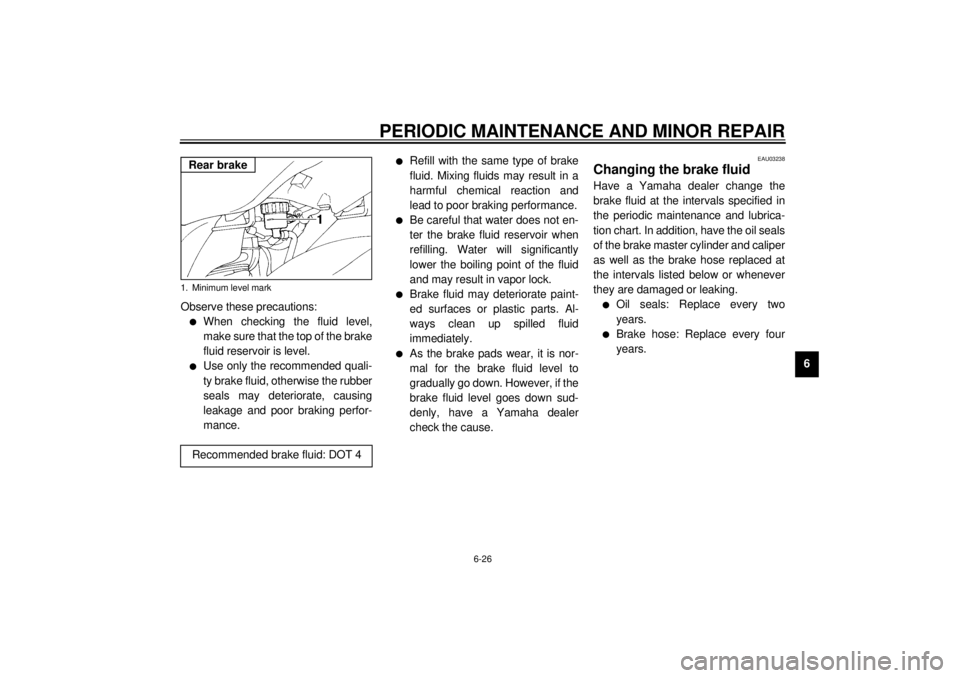Page 54 of 110

PERIODIC MAINTENANCE AND MINOR REPAIR
6-9
6
EAU01692
Engine oil and oil filter
element The engine oil level should be checked
before each ride. In addition, the oil
must be changed and the oil filter ele-
ment replaced at the intervals specified
in the periodic maintenance and lubri-
cation chart.
To check the engine oil level
1. Place the motorcycle on a level
surface and hold it in an upright
position.NOTE:@ Make sure that the motorcycle is posi-
tioned straight up when checking the oil
level. A slight tilt to the side can result in
a false reading. @2. Start the engine, warm it up for
15 minutes, and then turn it off.3. Check the oil level through the
check window located on the right
side of the engine oil tank.
NOTE:@ l
The engine oil tank is located be-
hind the cylinders.
l
The engine oil should be between
the minimum and maximum level
marks.
@4. If the engine oil is below the mini-
mum level mark, add sufficient oil
of the recommended type to raise
it to the correct level.To change the engine oil (with or
without oil filter element replace-
ment)
1. Start the engine, warm it up for
several minutes, and then turn it
off.
2. Place an oil pan under the engine
to collect the used oil.1. Engine oil level check window
2. Maximum level mark
3. Minimum level mark
1. Engine oil tank cap
E_4tx.book Page 9 Wednesday, October 4, 2000 4:28 PM
Page 71 of 110

PERIODIC MAINTENANCE AND MINOR REPAIR
6-26
6 Observe these precautions:
l
When checking the fluid level,
make sure that the top of the brake
fluid reservoir is level.
l
Use only the recommended quali-
ty brake fluid, otherwise the rubber
seals may deteriorate, causing
leakage and poor braking perfor-
mance.
l
Refill with the same type of brake
fluid. Mixing fluids may result in a
harmful chemical reaction and
lead to poor braking performance.
l
Be careful that water does not en-
ter the brake fluid reservoir when
refilling. Water will significantly
lower the boiling point of the fluid
and may result in vapor lock.
l
Brake fluid may deteriorate paint-
ed surfaces or plastic parts. Al-
ways clean up spilled fluid
immediately.
l
As the brake pads wear, it is nor-
mal for the brake fluid level to
gradually go down. However, if the
brake fluid level goes down sud-
denly, have a Yamaha dealer
check the cause.
EAU03238
Changing the brake fluid Have a Yamaha dealer change the
brake fluid at the intervals specified in
the periodic maintenance and lubrica-
tion chart. In addition, have the oil seals
of the brake master cylinder and caliper
as well as the brake hose replaced at
the intervals listed below or whenever
they are damaged or leaking.l
Oil seals: Replace every two
years.
l
Brake hose: Replace every four
years.
1. Minimum level mark
Recommended brake fluid: DOT 4Rear brake
E_4tx.book Page 26 Wednesday, October 4, 2000 4:28 PM
Page 98 of 110

8-1
8
EAU01038
8-SPECIFICATIONSSpecifications CS-01E
CS-01EModel TDM850
Dimensions
Overall length 2,165 mm (for GB, NL, B, F, E, P,
I, GR, D, DK)
2,200 mm (for N, S, SF)
Overall width 790 mm
Overall height 1,285 mm
Seat height 805 mm
Wheelbase 1,475 mm
Ground clearance 165 mm
Minimum turning radius 2,900 mm
Basic weight (with oil and full
fuel tank)
232 kg
Engine
Engine type Liquid-cooled 4-stroke, DOHC
Cylinder arrangement Forward-inclined parallel
2-cylinder
Displacement 849 cm
3
Bore ´ stroke 89.5 ´ 67.5 mm
Compression ratio 10.5:1
Starting system Electric starter
Lubrication system Dry sumpEngine oil
Ty p e
Recommended engine oil
classification API Service SE, SF, SG or
higher
Quantity
Without oil filter element
replacement 3.5 L
With oil filter element
replacement 3.6 L
Total amount (dry engine) 4.2 L
-20 -10 0
10 20 30
40
50 ˚C
SAE 10W-30
SAE 15W-40SAE 20W-40SAE 20W-50
SAE 10W-40
CAUTION:Be sure to use motor oils that do not contain anti-friction
modifiers. Passenger car motor oils (often labeled
“ENERGY CONSERVING II”) contain anti-friction additives
which will cause clutch and/or starter clutch slippage, result-
ing in reduced component life and poor engine performance.
E_4tx.book Page 1 Wednesday, October 4, 2000 4:28 PM
Page 100 of 110
SPECIFICATIONS
8-3
8
Maximum load* 203 kg
Tire air pressure
(measured on cold tires)
Up to 90 kg*
Front 225 kPa (2.25 kg/cm
2, 2.25 bar)
Rear 275 kPa (2.75 kg/cm2, 2.75 bar)
90 kg–maximum*
Front 225 kPa (2.25 kg/cm2, 2.25 bar)
Rear 275 kPa (2.75 kg/cm2, 2.75 bar)
High-speed riding
Front 225 kPa (2.25 kg/cm2, 2.25 bar)
Rear 275 kPa (2.75 kg/cm2, 2.75 bar)
* Total weight of rider, passenger, cargo and accessories
Wheels
Front
Type Cast wheel
Size 18 ´ MT 3.00
Rear
Type Cast wheel
Size 17 ´ MT 4.00Brakes
Front
Type Dual disc brake
Operation Right hand
Fluid DOT 4
Rear
Type Single disc brake
Operation Right foot
Fluid DOT 4
Suspension
Front Telescopic fork
Rear Swingarm (monocross)
Spring/shock absorber
Front Coil spring / oil damper
Rear Coil spring / gas-oil damper
Wheel travel
Front 149 mm
Rear 144 mm
E_4tx.book Page 3 Wednesday, October 4, 2000 4:28 PM